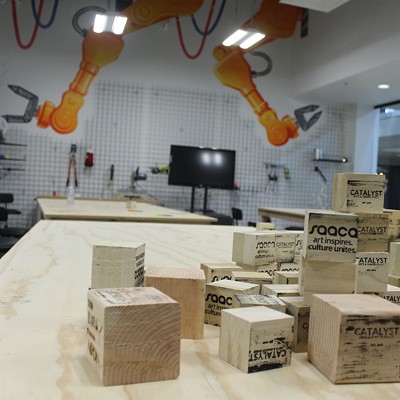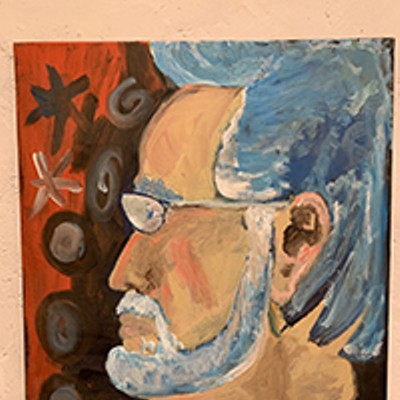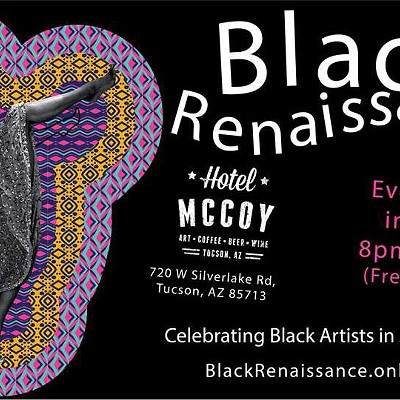Over the decades, as a metropolis sprung up around its borders, many, many creatures would cross the threshold into the Valley of the Moon. There were sprites and elves and princesses. There were dragons and goblins and trolls. There were witches and mad scientists and even performing bunnies. And there were children, thousands of children, and those who were still young at heart.
If you have visited the Valley of the Moon, you've learned about the power of fairies and the dangers of greed. In the springtime, you might have met a little lost girl named Alice and the curious crew she came across when she tumbled through a certain looking glass. And if you were lucky enough to stop by near the time of All Hallow's Eve, you may have met an avaricious alchemist, an evil wizard and a doctor who pulled something very, very nasty out of a little boy's nose.
But all these residents of the Valley of the Moon face a very grave danger, for the kingdom is falling into ruin, and its gates are shut until its champions can find a way to restore its vanishing glory.
Legend has it that four score and a couple of years ago (give or take), George Phar Legler set out to build a fantasyland on the edge of town--which today has a most mundane address of 2544 E. Allen Road.
Charlie Spillar, who is one of the stewards of the Valley of the Moon, spins quite a tale about George as he makes his way through the dusty pathways to the Enchanted Garden.
As Charlie tells the story, George was a spiritualist who believed that fairies and spirits were all around us, invisible to most eyes but doing very important work.
"He believed that right up until the day he died," says Charlie. "I'll tell you what: If fairies existed, they were here."
Sometime around 1920, George made the acquaintance of a young girl who was dying from consumption. He built her a replica of a tiny mountain with a lake and waterfall outside her bedroom window, telling her she could transport herself to that magical land whenever she was feeling down.
When he learned how the diorama cheered the spirit of the sickly girl, George went to work on his little two-acre patch of desert with the help of friends and hobos who needed a decent meal and a place to sleep. Together, they hauled rocks up from the riverbed and mixed concrete to build small castles and towers. They dug grottos and created hills. They filled small pools with water and assembled a stage and amphitheater.
When George was finally ready to receive visitors at his private park, he put a sign out front welcoming people to the "Valley of the Moon, Tucson's Picture in the Third Dimension and Mental Health Center."
In the early 1930s, George--who would come to call himself the Old Mountain Gnome--began giving guided tours of the Valley of the Moon on Friday nights, igniting the imagination of children with stories of fairies and magic. Dressed in black from head to toe, including a veil that covered his face, he led them past the Wizard's Tower, through Pennyland and into the Caves of Terror. Then they'd make a thrilling escape into the safety of the Enchanted Garden before the tour concluded with an exit through the Rabbit Hole. His granddaughter occasionally wore fairy wings and popped up in the show, as did other neighborhood kids as the Friday-night show became more elaborate.
His message to the children who entered the Valley of the Moon: "Kindness to all is the golden key to happiness."
George fancied himself as something of an entrepreneur as well. During the meat shortage of World War II, he came up with the idea of ranching frogs. When that plan went awry--"it was kind of a folly," notes Charlie--George turned to ranching rabbits instead. That didn't work quite as he planned, either, although it led to a new performance at the Valley of the Moon: Bunnyland Theatre, in which rabbits performed a variety of tricks, such as climbing ladders and hopping through bunny-sized castles.
The Old Mountain Gnome kept greeting visitors for more than three decades. A reporter from Life magazine stopped by in 1953, noting that George "tells the children fairy tales in which good deeds always bring rewards, and bad deeds are punished. He turns water into candy and makes a green feather become a snake. The children follow him, shivering at suggestions of danger but reassured by the magic pebbles and trinkets which Legler gives out as keepsakes and by their mothers following close behind."
But George, who was never in the best of health--he suffered from terrible ulcers--grew older, and vandals began causing trouble at the Valley of the Moon. Sometime in the mid-'60s, he gave his last tour and retreated to a small concrete room that looked out onto his enchanted garden.
George's decision to embrace the life of a hermit might have been the end of the story had it not been for a group of students at Catalina High School who remembered their visits to the Valley of the Moon as children. In 1971, they set out on a quest to find the lost fantasy land and discovered the Old Mountain Gnome, living in his tiny room and surviving on a diet of vitamin pills and condensed milk.
Together, George and the kids got to work fixing up the Valley of Moon. They repaired the castles, dug new tunnels and formed the Valley of the Moon Restoration Association. In 1975, the Valley of the Moon was listed on the Arizona Historic Places Register.
The Old Mountain Gnome struggled with his various ailments, but he would live long enough to see the Valley of the Moon restored to life before passing away in 1982 at the ripe old age of 97. His spirit would live on at the Valley of the Moon, which now belongs to the George Phar Legler Society.
In the years since George shuffled off this mortal coil, the members of the George Phar Legler Society have been true to his legacy, opening the Valley of the Moon to evening shows now and again, including a fright-filled Halloween show that runs through most of October. But all the magic in the Valley of the Moon hasn't been able to stop time from taking its toll.
Today's stewards are worried that the aging structures need repairs before children can safely return. In January, they gave their last tour and set about raising money for renovations. Charlie guesses, based on no particular figures, that the Valley of the Moon needs about a half-million dollars. He's a sculptor himself--one of his finest works was destroyed by a particularly heartless ogre in California--and has come to feel a kinship with old George, even though he never met the man.
Charlie and the other members of the George Phar Legler Society have been working with PRO Neighborhoods, a local organization that helps Tucson neighborhoods with planning issues. He's been meeting with engineers and historic preservation officials. And he's spent time with architect David Wald-Hopkins, whose firm is drawing up some plans for a renovated Valley of the Moon. One very difficult labor: making the enchanted park, with its narrow passageways, compliant with the Americans With Disabilities Act.
But Charlie remains certain in his heart that a happy ending is in store for this Tucson treasure.
"We'll get it done," he says. "There's still a lot of magic in this place."















